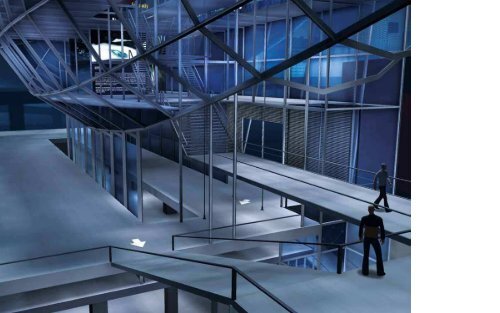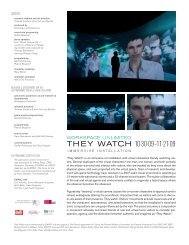Storyscape - Workspace Unlimited
Storyscape - Workspace Unlimited
Storyscape - Workspace Unlimited
You also want an ePaper? Increase the reach of your titles
YUMPU automatically turns print PDFs into web optimized ePapers that Google loves.
COMMON<br />
GROUNDS<br />
EXTENSION – 2003<br />
Commisioned by the Society for Arts & Technology, Montreal<br />
In Extension, Thomas Soetens and Kora Van den Bulcke built an<br />
online virtual architectural extension “on top of” the Society for Arts<br />
and Technology (SAT), and installed it on computers in the building in<br />
Montreal. Visitors inside the SAT, together with a Common Grounds<br />
audience, accessed Extension by first entering a digital replica of<br />
the building’s ground floor lobby, and then riding a fictional elevator<br />
to a dazzling virtual Zeppelin-like world of glass and steel.<br />
Once inside the extension, users explored a number of interactive<br />
digital art installations created with the Quake 3 gaming engine<br />
including: “<strong>Storyscape</strong>”, a 3D non-linear story with text and meanings<br />
literally distorting and shifting according to users’ movements; “Blind<br />
Love”, a game requiring two people to cooperate in order to find their<br />
way out of a darkened labyrinth; and “Infinite 60 Seconds”, a dynamic<br />
and generative soundscape based on a 60-second recording of a<br />
watch. One of the most disturbing installations, “Diplomatic Arena”,<br />
consisted of three deafening and visually bloody “levels” depicting<br />
the ethical bankruptcy of pre-emptive killing. Computer-controlled<br />
3D players (bots) depicting key figures in the media’s terrorism<br />
spectacle were programmed to engage in an endless and horrific<br />
cycle of futile self-destruction. Each time one bot killed another, it<br />
was immediately resurrected into the same never-ending<br />
cycle of retribution.<br />
Extension challenged visitors to consider how a real building might<br />
have an ongoing relationship with its networked virtual double. The<br />
artists suggested that the virtual extension exist simultaneously as<br />
a functioning addition to the actual building’s artistic programming<br />
and values, offering a new networked public temporally<br />
simultaneous activities in spatially discontinuous locations.<br />
20 24



